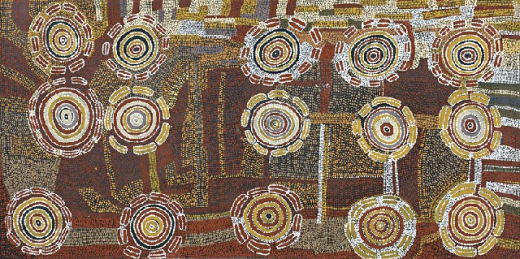Darby Jampijinpa Ross, 1905-2005, PAMAPARDU JUKURRPA (FLYING ANT DREAMING)
Darby Jampijinpa Ross, 1905-2005, PAMAPARDU JUKURRPA (FLYING ANT DREAMING)Estimate $30,000 – $50,000
synthetic polymer paint on linen
bears artist's name and Warlukurlangu Artists catalogue number 179/89 on the reverse
91 BY 183CM
Provenance:
Painted at Yuendumu in 1989
Warlukurlangu Artists, Yuendumu
Donald Kahn Collection
Exhibited:
Aboriginal Art from the Collection of Donald Kahn, Lowe Art Museum, University of Miami, Florida, 1991; Carolino Augusteum Museum, Salzburg, The Tel Aviv Museum, Tel Aviv, Naprstkovo Museum, Prague and The Museum of Ethnology, Warsaw during 1992-1993
Dreamings - Tjukurrpa: Aboriginal Art of the Western Desert, The Donald Kahn Collection, Museum Villa Stuck, Munich, 26 July-16 October 1994
Australian Aboriginal Art of the Western Desert- The Donald Kahn Collection, Fruit Market Gallery, Edinburgh, 3 December 1994-28 January 1995
Desert Dreaming: Australian Aboriginal Art, Albertina, Vienna, 15 June - 26 August 2007
Literature:
Geoffrey Bardon and Vivien Johnson, Australian Aboriginal Art from the Collection of Donald Kahn, Miami: Lowe Art Museum, University of Miami, 1991, p.55, cat.no.24 (iIlus.), pp.78-79
Jo-Anne Birnie Danzker (ed.), Dreamings - Tjukurrpa: Aboriginal Art of the Western Desert, The Donald Kahn Collection, Munich: Prestel Verlag, 1994, cat.no.24, pp.118-119 (colour illus.).
Cf. Yankirri Jukurrpa (Emu Dreaming), 1987, in the collection of the National Gallery of Victoria in Judith Ryan, (ed.), Colour Power: Aboriginal Art post 1984, in the collection of the National Gallery of Victoria, National Gallery of Victoria, Melbourne, 2004, p.30, and in Wally Caruana, Aboriginal Art, World of Art Series, London and New York: Thames and Hudson, 2003, p.135, pl.116.
Papamardu is one of the major Dreamings Darby Ross inherited and he was responsible for a number of associated sites, including one Flying Ant Dreaming place from which he got his traditional name, Wanyu. It is also a subject he painted frequently including two canvases in the collection of the National Gallery of Australia from 1992.
In the painting the double bars represent the flying ants while the roundels are their mounds. After rain, the flying ants or termites emerge from their nests and fly to a new, dry mound where they discard their wings. The presence of flying ants is regarded by the Warlpiri as a symbol of fertility.
This painting is sold with an accompanying Warlukurlangu Artists certificate

